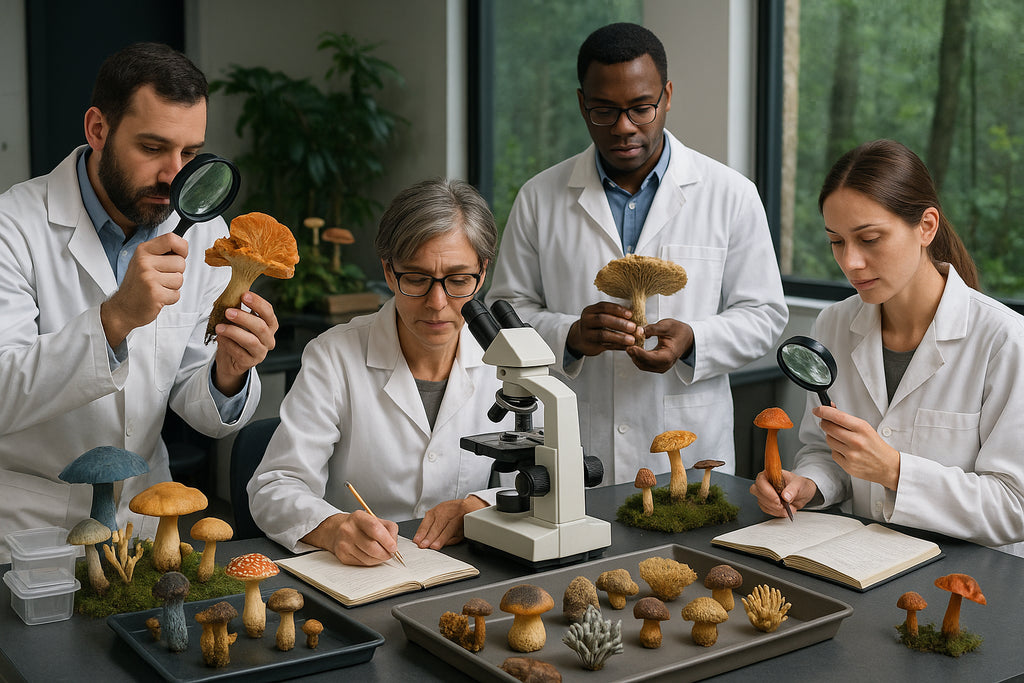Beyond the Known: The Hunt for New Psilocybin Mushrooms in 2024
Posted by SOUFIANE MESKINE

The world of mycology is far from fully mapped. While species like Psilocybe cubensis and Psilocybe semilanceata (liberty caps) have achieved widespread recognition, they represent just a fraction of nature's psychedelic pharmacy. In 2024, the scientific and amateur mycological communities are more active than ever, leading to the exciting discovery and formal classification of new psilocybin-containing mushrooms.
This isn't just about adding new names to a list; each discovery deepens our understanding of biodiversity, fungal evolution, and the potential future of psychedelic science.
The Thriving Field of Mycological Discovery
The hunt for new species is driven by two main forces:
-
Professional Mycologists: Academics and researchers who conduct systematic field studies, often in biodiversity hotspots, using DNA sequencing to definitively identify and classify new species.
-
Community Science (Citizen Mycology): Enthusiasts and amateur hunters around the world share photographs and samples on platforms like iNaturalist and Shroomery. This crowdsourced data often provides the initial clues that lead professionals to a new discovery.
The combination of these forces, aided by advanced genetic sequencing technology that has become more accessible, has created a golden age for fungal discovery.
2024's New Contenders: A Glimpse into Recent Finds
While a "new species" might be discovered in a given year, its formal publication and description in a scientific journal often happens later. The following are examples of significant species that have been described very recently or are gaining significant attention in 2024 for their unique properties.
1. Psilocybe ingeli (A Southern African Giant)
-
Discovery: While first found by locals and community scientists earlier, this species is now being formally studied and is creating a major buzz in 2024 due to its remarkable characteristics.
-
Habitat: Found in the grassy meadows of the Ingeli Mountain in southern Africa.
-
Significance: This is a massive mushroom. It can produce carpophores (fruiting bodies) with caps over 10 inches (25 cm) in diameter and stems over 11 inches (28 cm) long, dwarfing most known psilocybin species. Its potency is also reported to be significant, though formal analysis is ongoing. P. ingeli demonstrates that potent, large-bodied psilocybin species exist outside the traditional "hotspots" of Central and South America.
2. Psilocybe sirius (The Pacific Northwest's New Neighbor)
-
Discovery: Described in late 2023, this species is very new to the scientific community and is a major topic of discussion in 2024.
-
Habitat: Found in the Pacific Northwest of the United States, specifically in Oregon and Washington, growing from woody debris and chips.
-
Significance: P. sirius is a new part of the Psilocybe cyanescens (wavy cap) complex. It was distinguished from its relatives through DNA sequencing. Its discovery highlights that even in well-studied regions like the PNW, there is still hidden diversity. Understanding the subtle differences between these closely related species helps scientists understand their evolution and ecological roles.
3. Psilocybe venenata (The "Dangerous" Mimic)
-
Discovery: First documented in scientific literature very recently, with details still emerging in 2024.
-
Habitat: Reported from specific regions in South America.
-
Significance: The name venenata suggests a "venomous" or dangerous nature, which is intriguing. Early reports suggest it may be a look-alike to other non-psychoactive or even toxic species, making its proper identification critical for forager safety. Its discovery underscores the importance of proper identification and the potential dangers of amateur foraging without expert guidance.
4. The Ongoing Reclassification of Known Species
A major trend in 2024 isn't just finding brand-new mushrooms, but using genetics to correctly reclassify ones that were previously misidentified. A species once thought to be a simple variant of P. cubensis might, through DNA barcoding, be revealed as an entirely separate species with its own unique alkaloid profile. This "splitting" of species is a constant and vital process in modern mycology that refines our entire understanding of the genus Psilocybe.
Why Do These Discoveries Matter?
Finding a new mushroom is exciting, but the implications run much deeper:
-
Biodiversity and Conservation: Every new species discovered highlights the incredible, and often threatened, biodiversity of our planet. Understanding what exists is the first step to protecting it.
-
Novel Alkaloids and Chemistry: New species may produce unique combinations of psychoactive and non-psychoactive compounds. They might contain new analogs of psilocybin or other molecules that could have novel therapeutic effects, potentially opening new doors for medicine.
-
Understanding Evolution: By mapping the genetic relationships between new and old species, scientists can better understand how and why fungi evolved to produce psilocybin. Each new data point helps solve the puzzle of this molecule's ecological function.
-
Ethnobotanical Knowledge: In many cases, "new" species are already known to indigenous communities who have used them traditionally. Scientific discovery can help validate and preserve this traditional knowledge, creating a bridge between ancient wisdom and modern science.
A Word of Extreme Caution
The discovery of new species is a powerful reminder of a critical rule: Do not forage for or consume wild mushrooms based on online information or photos alone.
Misidentification can be fatal. Many toxic and lethal mushrooms closely resemble psilocybin-containing species. The consumption of any newly discovered or wild mushroom should only be done by experts with decades of experience in formal identification, and even then, with extreme caution.
The Future is Fungal
The discovery of new psilocybin mushrooms in 2024 proves that this field is alive with potential. As mycologists continue to explore the world's forests, fields, and even urban landscapes, we can expect the list of known species to keep growing. Each new fungus carries with it secrets about our world, the evolution of consciousness-altering compounds, and potentially, new keys to healing the human mind.
The message is clear: we have only just begun to scratch the surface of the psychedelic fungal kingdom.
